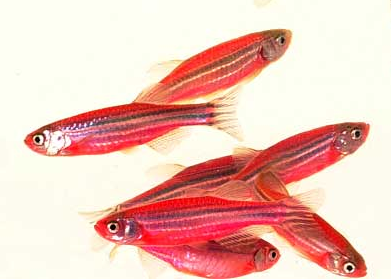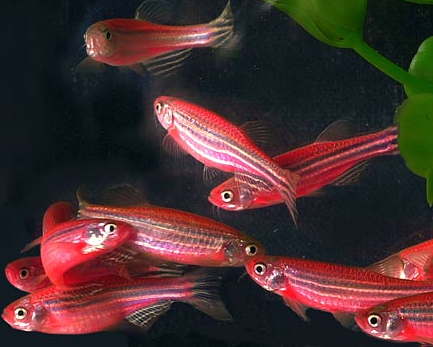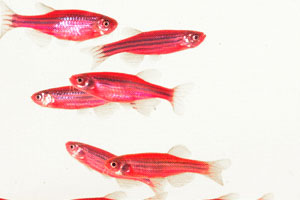Where do fluorescent zebra fish come from?
Fluorescent zebra fish were specially bred to help detect environmental pollutants. By adding a natural fluorescence gene to the fish, scientists are able to quickly and easily determine when our waterways are contaminated. The first step in developing these pollution detecting fish was to create fish that would be fluorescent all the time. It was only recently that scientists realized the public's interest in sharing the benefits of this research. We call this the GloFish™ fluorescent fish.
Do fluorescent fish glow?
Fluorescent fish absorb light and then re-emit it. This creates the perception that they are glowing, particularly when shining an ultraviolet light on the fish in a dark room.

How common is the use of fluorescent zebra fish in science?
For over a decade, fluorescent zebra fish have been relied upon by scientists worldwide to better understand important questions in genetics, molecular biology, and vertebrate development. Fluorescent zebra fish have been particularly helpful in understanding cellular disease and development, as well as cancer and gene therapy.
What are the differences between fluorescent zebra fish and other zebra fish?
Aside from their brilliant color, fluorescent zebra fish are the same as other zebra fish in every way. This includes everything from general care and temperature preferences to growth rate and life expectancy.
Does the fluorescence harm the fish?
No. The fish are as healthy as other zebra fish in every way. Scientists breed them by adding a natural fluorescence gene to the fish eggs before they hatch. The fish is born with this unique color, and maintains the color throughout its life. The color is also passed on to their offspring.

What will happen if a fluorescent zebra fish escapes into the waterways?
Zebra fish are tropical fish and are unable to survive in non-tropical environments. They have been sold to pet owners worldwide for more than fifty years. Despite all these years of aquarium ownership, zebra fish are only found in tropical environments, such as their native India .
What if a fluorescent zebra fish is eaten?
Eating a fluorescent zebra fish is the same as eating any other zebra fish. Their fluorescence is derived from a naturally occurring gene and is completely safe for the environment. Just as eating a blue fish would not turn a predator blue, eating a fluorescent fish would not make a predator fluoresce.

Are you going to create more fluorescent fish?
Scientists all around the world are working with fluorescent fish, whether it's to help protect the environment or come up with new disease-fighting drug therapies. As more fluorescent fish become available, they may be offered for sale to the public.
How can buying these fish help in the fight against pollution?
These fish have already existed for several years and were developed to help fight pollution. By breeding these existing fish, we will allow people to have their own fluorescent fish while promoting the beneficial scientific goals behind their development. In fact, a portion of the proceeds from sales will go directly to the lab where these fish were created in order to further their research—research we hope will help to